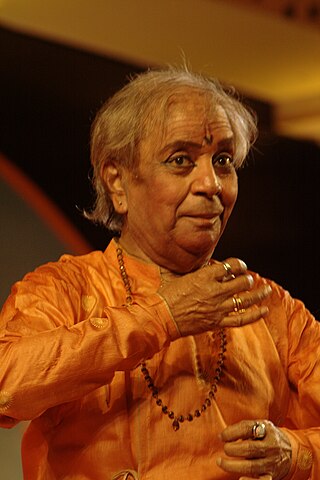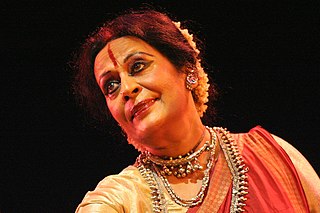
Pandit Birju Maharaj was an Indian dancer, composer, singer, and exponent of the Lucknow "Kalka-Bindadin" Gharana of Kathak dance in India. He was a descendant of the Maharaj family of Kathak dancers, which includes his two uncles, Shambhu Maharaj and Lachhu Maharaj, and his father and guru, Acchan Maharaj. He also practised Hindustani classical music and was a vocalist. After working along with his uncle, Shambhu Maharaj at Bhartiya Kala Kendra, later the Kathak Kendra, New Delhi, he remained head of the latter, for several years, until his retirement in 1998 when he opened his own dance school, Kalashram, also in Delhi.

Indian classical dance, or Shastriya Nritya, is an umbrella term for different regionally-specific Indian classical dance traditions, rooted in predominantly Hindu musical theatre performance, the theory and practice of which can be traced to the Sanskrit text Natya Shastra. The number of Indian classical dance styles ranges from eight to twelve, or more, depending on the source and scholar; the main organisation for Indian arts preservation, the Sangeet Natak Academy, recognizes eight – Bharatanatyam, Kathak, Kuchipudi, Odissi, Kathakali, Sattriya, Manipuri and Mohiniyattam. Additionally, the Indian Ministry of Culture includes Chhau in its list, recognising nine total styles. Scholars such as Drid Williams add Chhau, Yakshagana and Bhagavata Mela to the list. Each dance tradition originates and comes from a different state and/or region of India; for example, Bharatanatyam is from Tamil Nadu in the south of India, Odissi is from the east coast state of Odisha, and Manipuri is from the northeastern state of Manipur. The music associated with these different dance performances consists many compositions in Hindi, Malayalam, Meitei (Manipuri), Sanskrit, Tamil, Odia, Telugu, and many other Indian-Subcontinent languages; they represent a unity of core ideas, and a diversity of styles, costumes and expression.

Rukmini Devi Arundale was an Indian theosophist, dancer and choreographer of the Indian classical dance form of Bharatanatyam, and an activist for animal welfare.

Sonal Mansingh is an Indian classical dancer and Guru Bharatanatyam and Odissi dancing style. She has been nominated by the President of India to become a Member of Parliament, Rajya Sabha. She is the youngest recipient of Padma Bhushan in 1992 and Padma Vibhushan in 2003.

Sangeet Natak Akademi is the national level academy for performing arts set up by the Government of India.

Lata Pada, CM is an Indian-born Canadian choreographer and Bharatanatyam dancer. Pada is the founder and artistic director of Sampradaya Dance Creations, a dance company that performs South Asian dance. She is also the founder and director of Sampradaya Dance Academy, a leading professional dance training institution that is the only South Asian dance school in North America affiliated with the prestigious, UK-based Imperial Society for Teachers of Dancing. Pada founded the dance company in 1990; Pada said that she founded the company because she wanted to showcase Bharatantyam dance as an art form throughout the world. Pada is known as an influential figure in South Asian-style dance in Canada.
C. V. Chandrasekhar is an Indian Bharatanatyam dancer, academician, dance scholar, composer, and choreographer. He retired as Head of the Faculty of Performing Arts of M.S. University, Baroda in 1992. Professor Chandrashekhar and wife Jaya Chandrasekhar are one of the best known dancing couples of Bharata Natyam in India, during the 1970s and ’80s, they performed with their daughters Chitra and Manjari. Also, his grandchildren Viraj, Dhenuka, Harshavardhan and Amshuman have been of great support to him. He now runs his own dance institution, Nrityashree, in Chennai.
Chandralekha Prabhudas Patel, commonly known as just Chandralekha, was a dancer and choreographer from India. The niece of Vallabhbhai Patel, India's first deputy Prime Minister, she was an exponent of performances fusing Bharatanatyam with Yoga and martial arts like Kalarippayattu.
Alarmel Valli is a leading Indian classical dancer and choreographer and the foremost exponent of the Pandanallur style in the Indian classical dance form, Bharatanatyam. She is widely acclaimed for her ability to turn traditional grammar into deeply internalized, personal dance poetry.

Leela Samson is a Bharatanatyam dancer, choreographer, instructor, writer and actress from India. As a soloist, she is known for her technical virtuosity and has taught Bharatanatyam at Shriram Bhartiya Kala Kendra in Delhi for many years.

Kalanidhi Narayanan was an Indian dancer and teacher of Indian classical dance form of Bharatnatyam, who was the early non-devadasi girl to learn the dance form and perform it on stage in the 1930s and 1940s. After a brief career in the 1940s, she returned to dance in 1973 and became a notable teacher of abhinaya.
Jaya Seal is an Indian actress and dancer. She started learning Bharatanatyam from a very early age under Guru Indira P. P. Bora for five years. Simultaneously, she was also acting in Assamese television and did plays with noted Assamese theatre personalities from NSD like Dulal Roy and Baharul Islam who inspired her. To pursue this interest she went to the National School of Drama in New Delhi where she subsequently completed her three-year course in 1997.

Madhavi Mudgal is an Indian classical dancer known for her Odissi dance style. She has won several awards, including the Sanskriti Award, 1984, President of India's award of Padma Shri, 1990, the Orissa State Sangeet Natak Akademi Award, 1996, Grande Medaille de la Ville by Govt. of France, 1997, Central Sangeet Natak Akademi Award, 2000, Delhi State Parishad Samman, 2002 and the title of Nritya Choodamani in 2004.

Saroja Vaidyanathan is a choreographer, guru and a notable exponent of Bharatanatyam. She was conferred the Padma Shri in 2002 and the Padma Bhushan in 2013 by the Government of India.
Rohini Bhate was among the senior most Kathak dance exponents in India, who developed as a performer, teacher, writer, researcher and critic this Indian classical dance. During her career, she was awarded with several recognitions, such as the Sangeet Natak Akademi Award, and the Kalidas Samman.
Shanta Rao was a notable dancer from India. She studied and performed Kathakali, Bharatanatyam and Kuchipudi.
Madras Kadiravelu Saroja, is an Indian classical dancer, known for her expertise, as an exponent and as a teacher, in the classical dance form of Bharatanatyam. The Government of India honored her, in 2011, with the Padma Shri, the fourth highest civilian award, for her services to the field of art and culture.
Minati Mishra was an Indian classical dancer and actress, known for her expertise in the Indian classical dance form of Odissi. She was reported in 2011 to be the oldest-living Odissi performer. The Government of India honored Mishra in 2012, with the fourth-highest civilian award of Padma Shri.
Kanaka Srinivasan is an Indian classical dancer and one of the leading exponents of the classical dance form of Bharat Natyam. She is a disciple of Vazhuvoor B. Ramaiyah Pillai and is aligned with Vazhuvur tradition of the dance form. She is a recipient of the Sangeet Natak Akademi Award of 1998. The Government of India awarded her the fourth highest civilian honour of the Padma Shri, in 2006, for her contributions to Indian classical dance.
Meenakshi Chitharanjan, an Indian classical dancer, teacher and choreographer, is known as an exponent of the Pandanallur style of the classical dance form of Bharatanatyam. She is the founder of Kaladiksha, an institution promoting Bharatanatyam and striving to preserve the Pandanallur tradition. A disciple of the father-son duo of Chokkalingam Pillai and Subbaraya Pillai, she is a recipient of several honours including Kalaimamani Award of the Government of Tamil Nadu and the Natya Kala Sarathi of Sri Parthasarathy Swami Sabha. The Government of India awarded her the fourth highest civilian honour of the Padma Shri, in 2008, for her contributions to classical dance.










